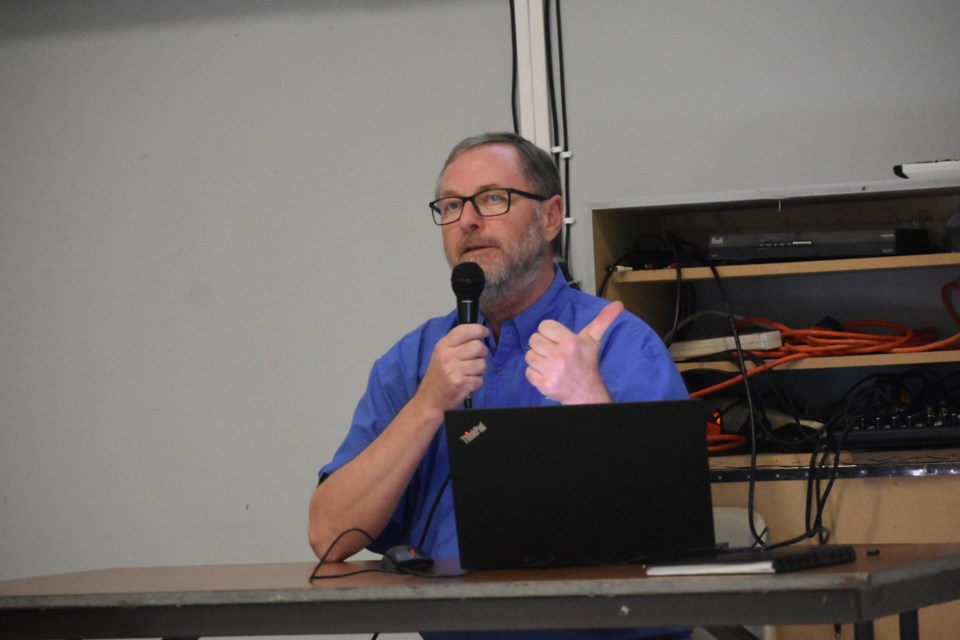MADGE LAKE — During a forest plan meeting held at the Duck Mountain Recreation Hall on Oct. 12, Pat Mackasey, a Park Forest ecologist based in Prince Albert, welcomed everyone to discuss forest management strategies, with a particular focus on aspen harvesting in Duck Mountain Provincial Park. Paul LeBlanc, a district forester with Louisana-Pacific (LP) Building Solutions, was also present to contribute to the meeting.
The meeting began with an introduction by Mackasey, who expressed gratitude for the attendees' participation and encouraged them to sign up for updates related to the discussed plans. Mackasey shared his role as a Park Forest ecologist within the Ministry of Parks, Culture, and Sport, emphasizing the collaborative nature of the presentation with Paul LeBlanc from LP Building Solutions.
The meeting's agenda included an overview of aspen harvesting in Duck Mountain Provincial Park over the past few years and the direction for the coming year. The team has been engaged in aspen harvesting in the park since 2014. Mackasey presented images from previous events to provide context and demonstrated the efforts made to reclaim and replant the area with nearly 50,000 trees in the spring of 2023.
Mackasey said, “I just want to give a quick update. If you've been following over the past few years what's going through we've done quite a bit of work in the past six, seven years on harvesting and most drones have now been reclaimed and replanted this year with just under 50,000 trees in the spring of 2023.”
A key point of discussion was the necessity of forest harvesting due to issues related to forest health. Old and variable forests, insufficient natural regeneration, and susceptibility to wildfires, insect infestations, and extreme weather events were highlighted as primary concerns. The depletion of forest biodiversity and wildlife habitat loss were also mentioned as significant factors.
LeBlanc provided insights into forest disturbance analysis and the challenges of forest regeneration in the park. The need for disturbances, such as fire or harvesting, to promote the growth of certain species was discussed. Challenges in achieving natural regeneration, especially for trembling Aspen, were noted.
Efforts to protect soil and forest floor layers during winter months when harvesting occurs were highlighted. The importance of leaving white spruce in harvested areas and the use of mechanical methods for harvesting were also emphasized. Reclamation efforts included replanting young trees, reclamation of roads, and others resulting in small ecological footprints once the forest matures.
LeBlanc said, “Another thing in the winter is all the migratory birds are long gone. There are resident birds like chickadees and ravens and so on. You're not exposing mineral soil and there's a lower overall risk and chance of affecting something.”
One of the key objectives of the operating plan is to promote the regeneration of the forest, particularly aspen trees. LeBlanc explained that aspen renewal is essential for maintaining a healthy forest ecosystem. By using variable retention harvesting during the winter season, they aim to create a diverse and vigorous aspen renewal. Variable retention harvesting involves leaving certain areas untouched or retaining specific tree patterns, which mimics the natural variability found in forests affected by fire.
Pat Mackasey highlighted strategies to manage access and protect habitats, especially for large mammals. Proposed closures and access restrictions were discussed to mitigate the impacts of harvesting and maintain a suitable environment for wildlife. Access management was emphasized to strike a balance between human activity and the preservation of the natural environment.
Mackasey said, “But actually, our park staff do a little more monitoring because LP does a good job doing the forest management aspects in the operation. So kind of offseason we go check out some areas and we have found some instances, as I mentioned, where people take quads and take the liberty to force their way back into some areas where they shouldn't be with machines. This becomes a compliance issue and we refer down into conservation officers and try to rectify the situation.”
The discussion also delved into species at risk and their habitats. Conservation efforts are in place to protect these species, ensuring their habitats are preserved during the harvesting process. Various species, such as the Eastern Comma Butterfly and tall blue lettuce were discussed in this context.
LeBlanc said, “There's a butterfly called the Eastern Comma. And I was surprised to find out it doesn't fly south for the winter. It goes into log piles and overwinters there and so we are to avoid running over those piles. We've got a plan where we watch for them now that we are going into winter. And to be clear, it's got to be a pile of logs not just a single log lying on the floor. So we'll protect their overwintering habitat that way.”
Additionally, the presentation touched upon the low-impact nature of winter logging, highlighting its benefits for maintaining healthy ecosystems. The cold weather helps minimize soil disruption during logging operations, making it an ideal time for harvest.
Don't count on social media to deliver your local news to you. Keep your news a touch away by bookmarking the Kamsack Times' homepage at this link.
Here's why you should bookmark your favourites.
Bookmark SASKTODAY.ca, Saskatchewan's home page, at this link.




